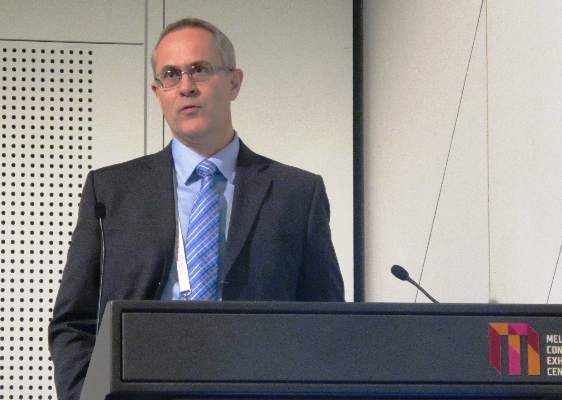User login
MELBOURNE – Patient-initiated follow-up is a safe, cost-effective alternative to conventional follow-ups every 3 months in patients with gynecological cancer, according to data from a prospective trial presented at the biennial meeting of the International Gynecologic Cancer Society.
Researchers found a much longer time to follow-up among patients who chose patient-initiated follow-up compared with those who elected to remain with conventional follow-up (718 days vs. 386 days), but the median time to death also was longer: 1,035 days in the patient-initiated follow-up group compared with 795 days in the conventional follow-up group.
“What is very clear is that many of our patients want an alternative to conventional follow up,” said Dr. Peter Larsen-Disney of the department of gynecology at Brighton and Sussex University Hospital NHS Trust, Brighton, England.
Dr Larsen-Disney told the conference that he realized patients with a good prognosis after treatment for their gynecological cancers were being given mixed messages by being asked to return for regular follow-up.
“We were saying, ‘there’s every reason to believe you’re cured, you have an excellent prognosis, and we’ll see you every 3 months,’ ” he said.
“The other realization I had was, with the exception of ovarian cancer patients, who we were following up for tumor markers, I believe that I make very few diagnoses of recurrence that the patient didn’t tell me was there.”
After realizing there was little evidence to support follow-up every 3 months in these patients, Dr. Larsen-Disney and his colleagues conducted a prospective study of 997 patients who were offered the choice of conventional follow-up or patient-initiated follow-up.
Patients who chose patient-initiated follow-up were registered in a database, and were provided with disease-specific booklets that outlined the follow-up system, listed details on what symptoms to look out for, and gave information on how to access review if needed.
Patients were able to access a nurse specialist by phone for advice and referrals for other services such as counseling.
Of the 568 patients who registered for patient-initiated follow-up, 71 later switched back to conventional follow-up, mostly at the time of recurrence.
More than half of the patients who registered for patient-initiated follow-up had endometrial cancer, while there were significantly more patients with cervical and vulvar cancer in the conventional follow-up arm than in the patient-initiated follow-up arm, which Dr. Larsen-Disney said partly reflected physician bias.
“We were a little bit reluctant to release the [patients with] very early cervix cancers back into the community because we wanted to follow them up with smears, and ... we weren’t confident that they would get the appropriate smears in the community,” he said.
He said there was no doubt in his mind of the importance of patient-led follow-up to the patients themselves, as well as the fact that it appeared to be a safe, acceptable, and cost-effective alternative to conventional follow-up.
“I think the concerns are that people are nervous that they’re going to miss recurrences and, to be honest, there will be a tiny minority of patients where you will, who won’t present with classical signs of recurrence but I’m not convinced you’d pick them up anyway,” Dr. Larsen-Disney said in an interview.
There were no conflicts of interest declared.
MELBOURNE – Patient-initiated follow-up is a safe, cost-effective alternative to conventional follow-ups every 3 months in patients with gynecological cancer, according to data from a prospective trial presented at the biennial meeting of the International Gynecologic Cancer Society.
Researchers found a much longer time to follow-up among patients who chose patient-initiated follow-up compared with those who elected to remain with conventional follow-up (718 days vs. 386 days), but the median time to death also was longer: 1,035 days in the patient-initiated follow-up group compared with 795 days in the conventional follow-up group.
“What is very clear is that many of our patients want an alternative to conventional follow up,” said Dr. Peter Larsen-Disney of the department of gynecology at Brighton and Sussex University Hospital NHS Trust, Brighton, England.
Dr Larsen-Disney told the conference that he realized patients with a good prognosis after treatment for their gynecological cancers were being given mixed messages by being asked to return for regular follow-up.
“We were saying, ‘there’s every reason to believe you’re cured, you have an excellent prognosis, and we’ll see you every 3 months,’ ” he said.
“The other realization I had was, with the exception of ovarian cancer patients, who we were following up for tumor markers, I believe that I make very few diagnoses of recurrence that the patient didn’t tell me was there.”
After realizing there was little evidence to support follow-up every 3 months in these patients, Dr. Larsen-Disney and his colleagues conducted a prospective study of 997 patients who were offered the choice of conventional follow-up or patient-initiated follow-up.
Patients who chose patient-initiated follow-up were registered in a database, and were provided with disease-specific booklets that outlined the follow-up system, listed details on what symptoms to look out for, and gave information on how to access review if needed.
Patients were able to access a nurse specialist by phone for advice and referrals for other services such as counseling.
Of the 568 patients who registered for patient-initiated follow-up, 71 later switched back to conventional follow-up, mostly at the time of recurrence.
More than half of the patients who registered for patient-initiated follow-up had endometrial cancer, while there were significantly more patients with cervical and vulvar cancer in the conventional follow-up arm than in the patient-initiated follow-up arm, which Dr. Larsen-Disney said partly reflected physician bias.
“We were a little bit reluctant to release the [patients with] very early cervix cancers back into the community because we wanted to follow them up with smears, and ... we weren’t confident that they would get the appropriate smears in the community,” he said.
He said there was no doubt in his mind of the importance of patient-led follow-up to the patients themselves, as well as the fact that it appeared to be a safe, acceptable, and cost-effective alternative to conventional follow-up.
“I think the concerns are that people are nervous that they’re going to miss recurrences and, to be honest, there will be a tiny minority of patients where you will, who won’t present with classical signs of recurrence but I’m not convinced you’d pick them up anyway,” Dr. Larsen-Disney said in an interview.
There were no conflicts of interest declared.
MELBOURNE – Patient-initiated follow-up is a safe, cost-effective alternative to conventional follow-ups every 3 months in patients with gynecological cancer, according to data from a prospective trial presented at the biennial meeting of the International Gynecologic Cancer Society.
Researchers found a much longer time to follow-up among patients who chose patient-initiated follow-up compared with those who elected to remain with conventional follow-up (718 days vs. 386 days), but the median time to death also was longer: 1,035 days in the patient-initiated follow-up group compared with 795 days in the conventional follow-up group.
“What is very clear is that many of our patients want an alternative to conventional follow up,” said Dr. Peter Larsen-Disney of the department of gynecology at Brighton and Sussex University Hospital NHS Trust, Brighton, England.
Dr Larsen-Disney told the conference that he realized patients with a good prognosis after treatment for their gynecological cancers were being given mixed messages by being asked to return for regular follow-up.
“We were saying, ‘there’s every reason to believe you’re cured, you have an excellent prognosis, and we’ll see you every 3 months,’ ” he said.
“The other realization I had was, with the exception of ovarian cancer patients, who we were following up for tumor markers, I believe that I make very few diagnoses of recurrence that the patient didn’t tell me was there.”
After realizing there was little evidence to support follow-up every 3 months in these patients, Dr. Larsen-Disney and his colleagues conducted a prospective study of 997 patients who were offered the choice of conventional follow-up or patient-initiated follow-up.
Patients who chose patient-initiated follow-up were registered in a database, and were provided with disease-specific booklets that outlined the follow-up system, listed details on what symptoms to look out for, and gave information on how to access review if needed.
Patients were able to access a nurse specialist by phone for advice and referrals for other services such as counseling.
Of the 568 patients who registered for patient-initiated follow-up, 71 later switched back to conventional follow-up, mostly at the time of recurrence.
More than half of the patients who registered for patient-initiated follow-up had endometrial cancer, while there were significantly more patients with cervical and vulvar cancer in the conventional follow-up arm than in the patient-initiated follow-up arm, which Dr. Larsen-Disney said partly reflected physician bias.
“We were a little bit reluctant to release the [patients with] very early cervix cancers back into the community because we wanted to follow them up with smears, and ... we weren’t confident that they would get the appropriate smears in the community,” he said.
He said there was no doubt in his mind of the importance of patient-led follow-up to the patients themselves, as well as the fact that it appeared to be a safe, acceptable, and cost-effective alternative to conventional follow-up.
“I think the concerns are that people are nervous that they’re going to miss recurrences and, to be honest, there will be a tiny minority of patients where you will, who won’t present with classical signs of recurrence but I’m not convinced you’d pick them up anyway,” Dr. Larsen-Disney said in an interview.
There were no conflicts of interest declared.
AT IGCS 2014
Key clinical point: Patient-initiated follow-up is a safe, cost-effective alternative to conventional follow-up every 3 months in patients with gynecological cancer.
Major finding: Patient-led follow-up was associated with a median follow-up of 742 days compared to 386 days with conventional follow-up.
Data source: Prospective study of 997 women with gynecological cancer.
Disclosures: No conflicts of interest declared.

